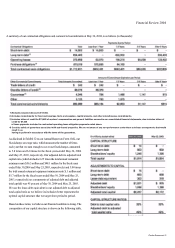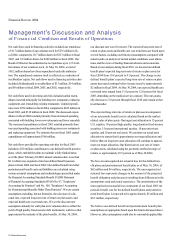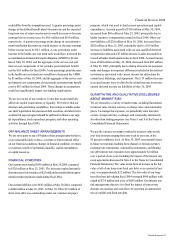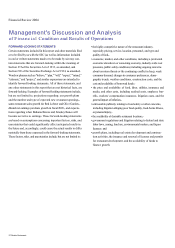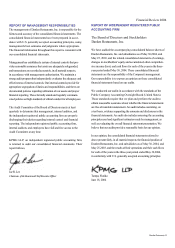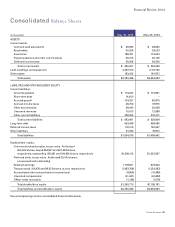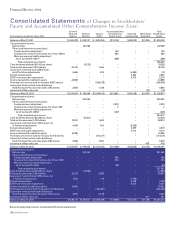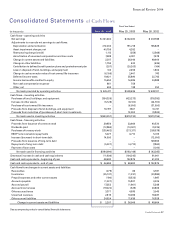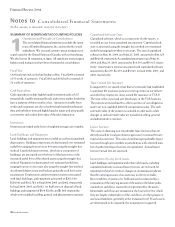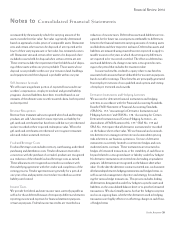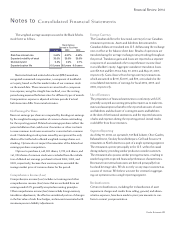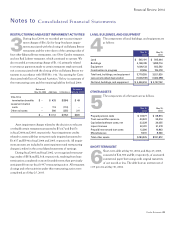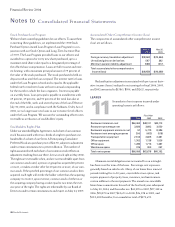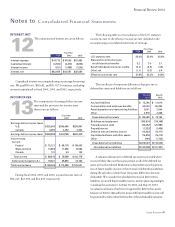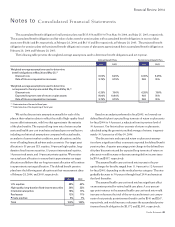Red Lobster 2004 Annual Report Download - page 39
Download and view the complete annual report
Please find page 39 of the 2004 Red Lobster annual report below. You can navigate through the pages in the report by either clicking on the pages listed below, or by using the keyword search tool below to find specific information within the annual report.Notesto
Consolidated Financial Statements
is measured by the amount by which the carrying amount of the
assets exceeds their fair value. Fair value is generally determined
based on appraisals or sales prices of comparable assets. Restaurant
sites and certain other assets to be disposed of are reported at the
lower of their carrying amount or fair value, less estimated costs to
sell. Restaurant sites and certain other assets to be disposed of are
included in assets held for disposal when certain criteria are met.
These criteria include the requirement that the likelihood of dispos-
ing of these assets within one year is probable. Those assets whose
disposal is not probable within one year remain in land, buildings,
and equipment until their disposal is probable within one year.
Self-Insurance Accruals
We self-insure a significant portion of expected losses under our
workers’ compensation, employee medical, and general liability
programs. Accrued liabilities have been recorded based on our
estimates of the ultimate costs to settle incurred claims, both reported
and unreported.
Revenue Recognition
Revenue from restaurant sales is recognized when food and beverage
products are sold. Unearned revenues represent our liability for
gift cards and certificates that have been sold but not yet redeemed
and are recorded at their expected redemption value. When the
gift cards and certificates are redeemed, we recognize restaurant
sales and reduce unearned revenues.
Food and Beverage Costs
Food and beverage costs include inventory, warehousing, and related
purchasing and distribution costs. Vendor allowances received in
connection with the purchase of a vendor’s products are recognized
as a reduction of the related food and beverage costs as earned.
These allowances are recognized as earned in accordance with
the underlying agreement with the vendor and completion of the
earning process. Vendor agreements are generally for a period of
one year or less and payments received are recorded as a current
liability until earned.
Income Taxes
We provide for federal and state income taxes currently payable as
well as for those deferred because of temporary differences between
reporting income and expenses for financial statement purposes
versus tax purposes. Federal income tax credits are recorded as a
reduction of income taxes. Deferred tax assets and liabilities are rec-
ognized for the future tax consequences attributable to differences
between the financial statement carrying amounts of existing assets
and liabilities and their respective tax bases. Deferred tax assets and
liabilities are measured using enacted tax rates expected to apply to
taxable income in the years in which those temporary differences
are expected to be recovered or settled. The effect on deferred tax
assets and liabilities of a change in tax rates is recognized in earn-
ings in the period that includes the enactment date.
Income tax benefits credited to equity relate to tax benefits
associated with amounts that are deductible for income tax purposes
but do not affect earnings. These benefits are principally generated
from employee exercises of non-qualified stock options and vesting
of employee restricted stock awards.
Derivative Instruments and Hedging Activities
We account for derivative financial instruments and hedging
activities in accordance with the Financial Accounting Standards
Board’s (FASB) Statement of Financial Accounting Standards
(SFAS) No. 133, “Accounting for Derivative Instruments and
Hedging Activities” and SFAS No. 138, “Accounting for Certain
Derivative Instruments and Certain Hedging Activities – an
Amendment of FASB Statement No. 133.” SFAS No. 133 and
SFAS No. 138 require that all derivative instruments be recorded
on the balance sheet at fair value. We use financial and commodi-
ties derivatives to manage interest rate and commodities pricing
risks inherent in our business operations. Our use of derivative
instruments is currently limited to interest rate hedges and com-
modities futures contracts. These instruments are structured as
hedges of forecasted transactions or the variability of cash flows to
be paid related to a recognized asset or liability (cash flow hedges).
No derivative instruments are entered into for trading or speculative
purposes. All derivatives are recognized on the balance sheet at fair
value. On the date the derivative contract is entered into, we document
all relationships between hedging instruments and hedged items, as
well as our risk-management objective and strategy for undertak-
ing the various hedge transactions. This process includes linking
all derivatives designated as cash flow hedges to specific assets and
liabilities on the consolidated balance sheet or to specific forecasted
transactions. We also formally assess, both at the hedge’s inception
and on an ongoing basis, whether the derivatives used in hedging
transactions are highly effective in offsetting changes in cash flows
of hedged items.
39
Financial Review 2004


